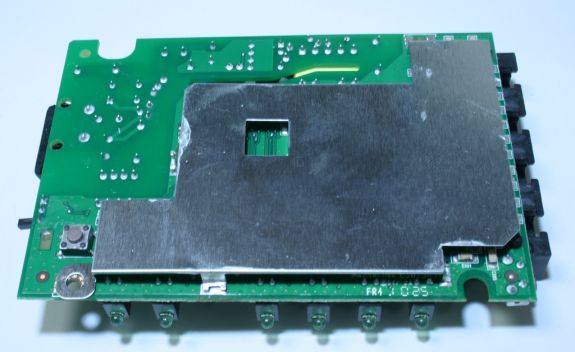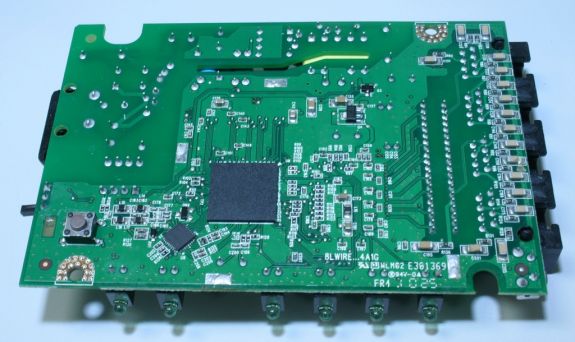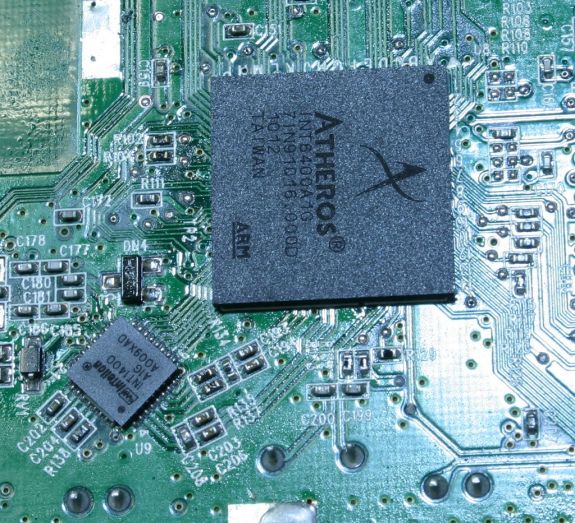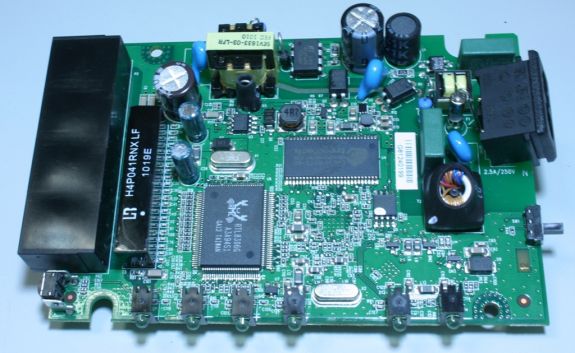Powerline Networking with the Western Digital Livewire
by Ganesh T S on August 24, 2010 7:50 AM EST- Posted in
- Gadgets
- Networking
- Powerline Adapters
At AnandTech, we are always interested in getting to know what actually powers the units we review. The WD Livewire happens to be the first powerline adapter product that we are reviewing. Though we had heard about Atheros/Intellon and Gigle Networks before, it is always exciting to open up one of the kits and confirm the chips ourselves. One of the routing units was given the teardown treatment, and the results are presented below for your viewing pleasure.
The routing unit appears quite impregnable, until one realizes that two out of the four circular gripping pads at the bottom of the unit hide screws beneath them. Once these were out of the way, disassembling was fairly straightforward. Removing the bottom plastic plate revealed a thin metal film covering the PCB. The intent of this metal film is to act as a shield for the heat generated by the chip behind and prevent it from possibly melting the underside of the unit. The metal film is held in place by two screws and is also soldered to the PCB.

Metal Film for Thermal Protection
After unscrewing and unsoldering the metal film, we are presented with the underside of the PCB, which contains the main chips enabling the powerline networking functionality. Our suspicions are confirmed, with the Atheros INT6400 chip, as well as the Intellon AFE (Analog Front End), INT1400 (PDF) making an appearance.

The Underside is Largely Unpopulated Except for the Powerline Chips

Up Close with the Powerline Chips
With a little bit of maneuvering, it is also possible to completely remove the PCB from the casing (as we have already done in this section's pictures). The top portion of the PCB shows a transformer, multiple capacitors and the Realtek RTL8306G 6 port Fast Ethernet switch controller. EtronTech supplies the DRAM for the chipset, and is the other big chip which can be seen in the photograph.
So, we have taken a look at the internals of the WD Livewire. In the next section, we will look at how it performs.











31 Comments
View All Comments
PlcBooster - Saturday, September 11, 2010 - link
Hi Souka,Firstly, I would like to convey my Big KUDOS! to Mr. Ganesh T S on his good and inside report on the Powerline Networking with the Western Digital Livewire. He furnished us with very informative good and un bias reports.
I bet many people, end users or rather consumers are quite dismay after they use the PLC adapters and put them into real action ie use at home or at their office.
But hold on your dismay, cos, there is a company in APAC that I know can help or overcome this 10 years inherent issues that have been plaguing these PLC manufacturers, they will be planning to launch their product once they find the right business partner, may be Western Digital Livewire, if WD are keen to explore with them. So that the PLC adapters adoption and acceptance rate will surely flourish worldwide with an affordable price of course. :)
Cheers! to Mr. Ganesh!
PlcBooster - Thursday, December 23, 2010 - link
There is light at the end of the tunnel for all PLC adapters manufacturers, distributors & end usersKindly feel free to view these three short informative videos at the following links below:
PLC-adapters have been proven to perform better with Surestreamer
Part 1
http://www.youtube.com/watch?v=84C7k...eature=rela...
Part 2
http://www.youtube.com/watch?v=fV6Jn...eature=rela...
Part 3
http://www.youtube.com/watch?v=jQuQg...eature=rela...
Thank you very much & Merry Christmas!
casteve - Tuesday, August 24, 2010 - link
Ganesh, thanks for the review. Since WD wants this device to be plugged into the wall and not into a surge protector power strip or UPS:1) How much AC power do the two units use?
2) Do they have an on/off switch?
3) Is there surge protection circuitry built in and are there any guarantees to it? Seems like there would be a surge path via the ethernet ports.
ganeshts - Tuesday, August 24, 2010 - link
casteve,The device acts as a router of sorts, consuming around 3 - 3.5 W. Load or no-load didn't make much of a difference with the Kill-a-watt I was using (it is not really accurate at such low power numbers).
It does have an on-off switch right next to the power connection point.
I will get back to you on the surge protection circuitry in a bit.
ganeshts - Tuesday, August 24, 2010 - link
casteve, I have unofficial confirmation from outside sources that the board design also has surge protection circuitry built in. I am still waiting to hear back officially from WD PR.casteve - Thursday, August 26, 2010 - link
Thanks for the power usage info.yyrkoon - Wednesday, August 25, 2010 - link
Yes, sometimes it is very hard to fish cabling though a wall to get what you want exactly where you need it but come on folks. There are so many neat and tidy ways to run cabling, surely most anyone can find a way to get it done.Such as pulling the floor trim off of the wall, and running cable behind it. Wont work for you ? Raise it up a bit, and run the cabling just under the floor trim(sometimes all that is needed is a wedge, and a screwdriver). Or how about; Under the carpet in the corner of the wall . . . all that is required is a little imagination, and wiliness to spend some time to get it done.
*Or* if things are extremely tough, you can drill a few strategic holes where you *know* you will not cut into anything important ( like power runs or plumbing, etc ), and fish from point A to B to . . .Z. It is not as though doing wall patch work is all that difficult. Again, all that is required is a bit of imagination, and time to achieve. Anyone can make excuses.
I shudder to think of the alternative. Which is *hoping* your electrical is clean / noise free enough to use something that in this persons humble opinion should never have even been given a second thought.
Brucmack - Wednesday, August 25, 2010 - link
I've been using two Amitech home plugs for a while to connect my media box under my TV to the rest of my network. There are a couple of "gotchas" to consider. First, if you have a house with really old wiring, don't expect to get a very stable or fast connection. Second, some chargers can interfere with the signal, especially if you use the homeplug on a power strip. But basically if you can get a stable signal, it's quicker and more reliable than wireless.kwlinca - Wednesday, August 25, 2010 - link
Powerline technology only works when connecting 2 locations on the SAME circuit. My computer is located on one circuit in the front of the house and my AV equipment is located on a different circuit in the back of my house. It is only when you read the fine print that you find this out.Welshtrog - Wednesday, August 25, 2010 - link
The problem with these units is that they are effectively broadband transmitters and cover a large section of the radio spectrum which is why radio users object to their use and objectors can cause them to be removed. by ofcom